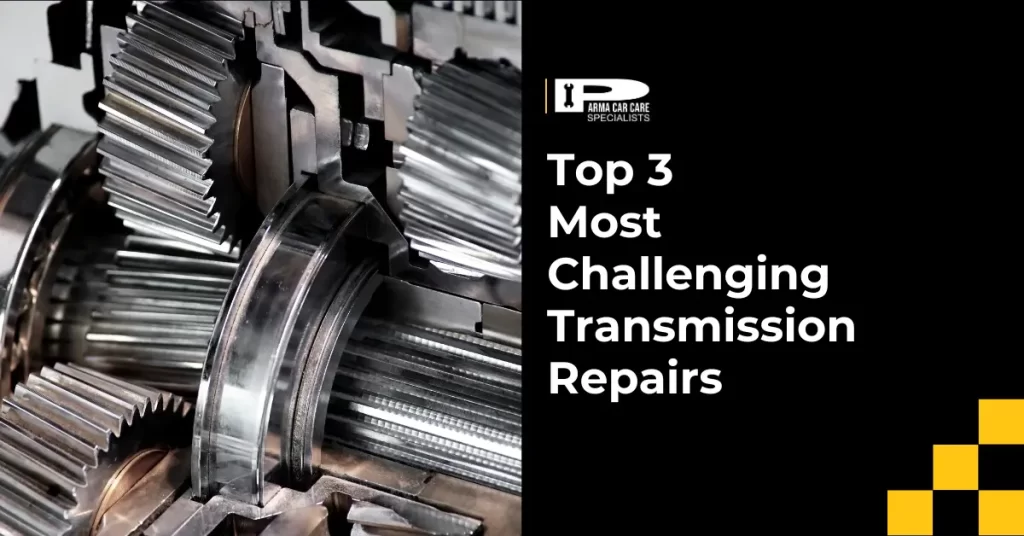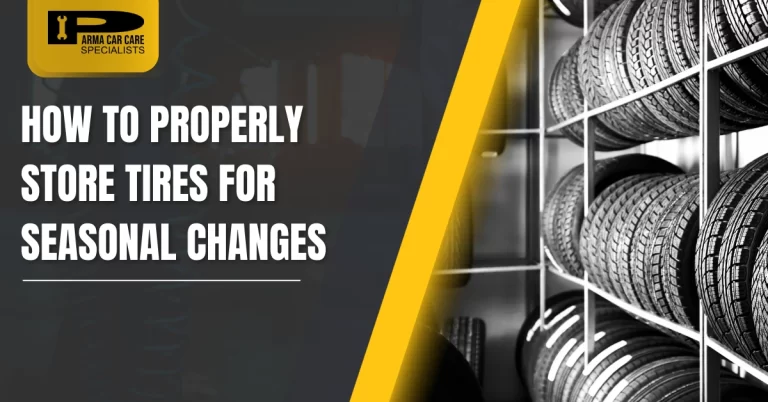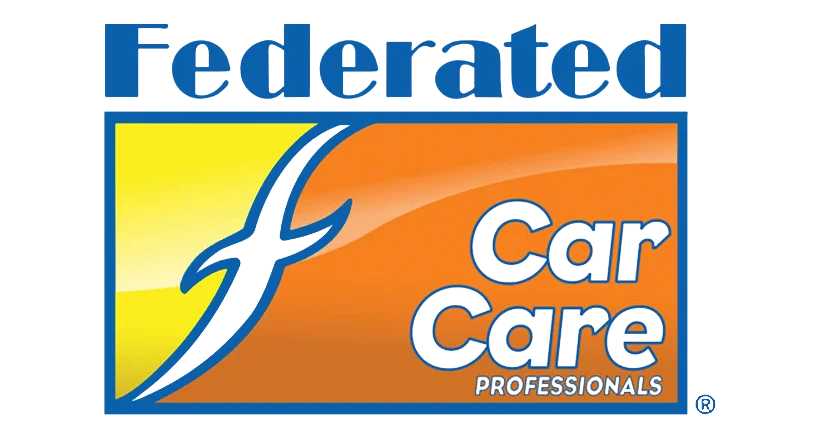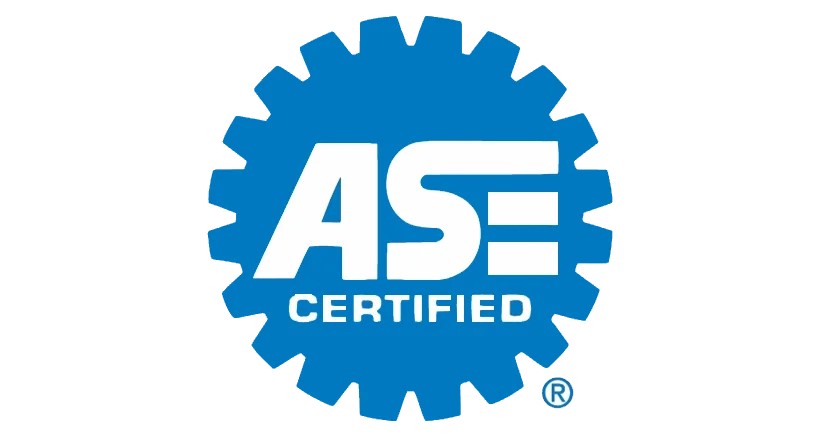You’ll find manual transmission overhauls, CVT repairs, and dual-clutch transmission rebuilds to be the top three most challenging transmission repairs. Manual overhauls involve disassembly, precision measurements, and exact alignment for reassembly. CVTs use belts and pulleys, requiring specialized tools and exacting calibration due to their electronic integration. Dual-clutch systems feature two clutches managing separate gear sets, involving intricate diagnosis of solenoid and hydraulic issues, and demanding precise torque specs during reassembly. Each type presents unique difficulties, but mastering these can greatly improve your automotive repair skills. Continue to discover more detailed aspects of each process.
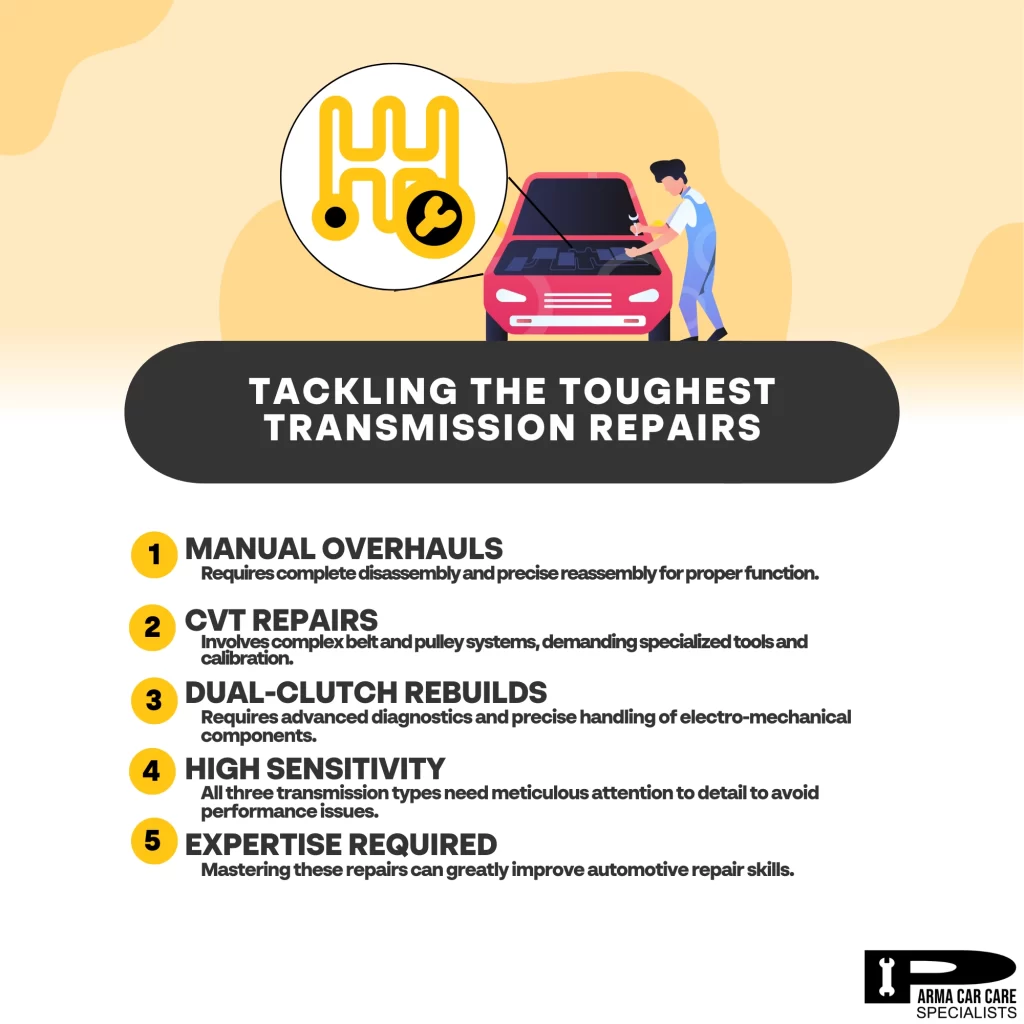
Key Takeaways
- Manual transmission overhauls require complete disassembly, precise measurements, and exact reassembly to prevent failure.
- CVT repairs involve complex belt and pulley systems, necessitating specialized tools and software recalibration.
- Dual-clutch transmission rebuilds demand advanced diagnostic tools, careful handling, and strict adherence to torque specifications.
- Accessing internal components in CVTs is often difficult, complicating disassembly and reassembly processes.
- Dual-clutch transmissions frequently experience clutch slippage and solenoid failures, requiring detailed attention during repairs.
Manual Transmission Overhaul
A manual transmission overhaul, often referred to as a rebuild, involves disassembling the entire transmission to inspect, clean, and replace worn or damaged components. This process is one of the hardest things to fix on a car due to its intricate nature. You’ll need to start by removing the transmission from the vehicle, which requires disconnecting it from the engine and drivetrain.
Once the transmission is out, you’ll disassemble it to access the internal parts like gears, synchros, bearings, and seals. Each component must be meticulously inspected for wear or damage. Precision tools are necessary to measure tolerances and guarantee parts meet manufacturer specifications. If you find worn components, they’ll need replacing, often with OEM or high-quality aftermarket parts.
Reassembly is equally challenging, requiring exact alignment of gears and proper torque settings for bolts. Any mistake can lead to poor performance or even total transmission failure. Specialized knowledge of manual transmission systems is vital, as is an understanding of how each part interacts within the system. Given its complexity and the precision required, a manual transmission overhaul stands as one of the hardest things to fix on a car.
CVT (Continuously Variable Transmission) Repair
Ever wondered why CVT repairs can be so intricate? Continuously Variable Transmissions (CVTs) are unique because they don’t use traditional gears. Instead, they employ a system of belts and pulleys to provide a seamless range of gear ratios. This design offers numerous benefits regarding fuel efficiency and smooth driving experience, but it also adds complexity when it comes to repairs.
- Precision Components: CVTs rely on high-precision parts, making any misalignment or wear a critical issue.
- Specialized Tools: Repairing CVTs often requires unique, specialized tools that aren’t typically used for other types of transmissions.
- Software Calibration: Modern CVTs are integrated with the car’s electronic control system, necessitating software recalibration after physical repairs.
- Limited Accessibility: CVT components are often located in hard-to-reach areas, complicating disassembly and reassembly.
- High Sensitivity: The belt and pulley system is highly sensitive to wear and tear, demanding meticulous attention to detail during repairs.
When dealing with CVT repairs in cars, you need to have a deep understanding of the internal mechanics and the specific requirements of each component. The slightest error can lead to significant performance issues, making these repairs some of the most challenging in the automotive industry.
Dual-Clutch Transmission Rebuild
Understanding the intricacies of CVT repairs sets the stage for tackling another complex transmission system: the Dual-Clutch Transmission (DCT). In DCTs, two separate clutches manage odd and even gear sets, facilitating rapid shifts. Rebuilding a DCT isn’t a straightforward task; it demands a nuanced understanding of its electro-mechanical components and intricate design.
First, you’ll need to diagnose the system using advanced diagnostic tools like a scan tool capable of reading transmission-specific codes. DCTs often present issues like clutch slippage, solenoid failures, or hydraulic leaks. Once pinpointed, disassembly requires careful handling. Extracting the transmission from the car and separating the dual-clutch assembly from the gearbox are meticulous steps involving specialized tools and precise alignment.
During the rebuild, each clutch pack must be inspected for wear and replaced if necessary. Solenoids and sensors also require thorough testing or replacement. Reassembling is equally complex, demanding exact torque specifications and calibration procedures. Misalignment or improper assembly can lead to further malfunctions, making it imperative to follow OEM guidelines precisely.
In essence, DCT repairs for cars combine mechanical expertise with advanced diagnostic capabilities, making them one of the most challenging yet rewarding transmission repairs in the automotive industry.
Conclusion
Just imagine: your manual transmission overhaul, done with precision. But wait, the CVT repair, with its intricate belt system, is next in line. And finally, the dual-clutch transmission rebuild, a dance of gears and clutches, awaits. Each step demands unparalleled expertise and attention to detail. Are you ready to tackle these formidable challenges? With the right knowledge and skills, you’ll conquer them all, guaranteeing your vehicle runs smoother than ever. Get ready to master the most challenging repairs.


